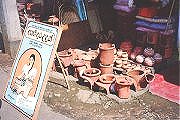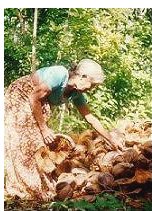

Sri Lanka 
 |
Wood Energy Situation Policies and Programmes Wood Energy Data Further Reading RWEDP Focal Points |
Wood Energy Situation
Sri Lanka has no oil or natural gas reserves. Forest products and agricultural residues are of central importance to Sri Lanka's overall energy supply. Estimates suggest that biomass use accounts for about 55% of total energy consumption, and 49% comes from woodfuels. Biomass fuels are consumed mostly households, but also by industry. Biomass energy consumption has been increasing by 3% annually, whereas the share of biomass used in the total energy consumption has decreased slightly in recent years.
Sawdust, a potential fuel, is still wasted in Sri Lanka. Coir dust is utilised as a soil conditioner in other countries, and therefore earns foreign currency and alleviates an environmental burden in Sri Lanka. Therefore, it is no longer freely available as a potential fuel. Fuel from rubber wood is no longer abundant in Sri Lanka.
Policies and Programmes
 The Government is finalising the National Forestry Plan, which will be available to FAO soon. One section states that bio-energy remains important in Sri Lanka. This is confirmed by the Ministry of Irrigation, Power and Energy. Figures on biomass energy, including fuelwood and charcoal, have been shown on Sri Lanka's national energy balance for about 10 years. Annual updates are made, although some of the data is not considered reliable. For instance, woodfuel-using industries are not incorporated. In Sri Lanka, as in other countries, rural industries apply poor technologies to the use of woodfuel, and many improvements have yet to be put in place.
The Government is finalising the National Forestry Plan, which will be available to FAO soon. One section states that bio-energy remains important in Sri Lanka. This is confirmed by the Ministry of Irrigation, Power and Energy. Figures on biomass energy, including fuelwood and charcoal, have been shown on Sri Lanka's national energy balance for about 10 years. Annual updates are made, although some of the data is not considered reliable. For instance, woodfuel-using industries are not incorporated. In Sri Lanka, as in other countries, rural industries apply poor technologies to the use of woodfuel, and many improvements have yet to be put in place.
About 15% of the foreign exchange earnings of the country are used to import fossil fuels. The country recently received a soft loan from the World Bank for renewable energy, including solar, wind and mini-hydro. The ministry is preparing a feasibility study for dendro-thermal power generation in the mountain areas, for funding by the EU. For about two years private sector power generators have been allowed to sell electricity to the Ceylon Electricity Board (CEB). This has a positive impact on mini-hydro power. Cogeneration can hardly be developed in Sri Lanka, except at sugar mills. However, most mills have no interest in producing excess power for selling.
Sri Lanka is known for past successful wood stove programmes, which have been run with support from RWEDP and ITDG, and with funding from the Netherlands Government. One of the rather unique features was that the programme was supervised and implemented by the CEB, as an electricity organisation. The stove programmes of the CEB, both rural and urban, have been terminated as improved stoves are now made by the private sector and are widely available on the market. Some stove projects are still run by NGOs, like IDEA, with which RWEDP has close links.
Wood Energy Data
| General | |||||
| Population (1996) | 18.1 mln. | ||||
| Share of Rural Population | 77.3% | ||||
| GDP per capita (1993) in constant 1987 US$ | 493 | ||||
| Energy Consumption (1996) | |||||
| Total Final Energy Consumption in PJ | 250.0 | ||||
| Consumption of Wood Energy in PJ | 159.3 | (63.7%) | |||
| Consumption of Biomass Energy in PJ | 164.3 | (65.7%) | |||
| Wood Energy Resources | |||||
| Forest Area (1995) in 1000 ha | 1,796 | (27.8%) | |||
| Natural Forest Area (1995) in 1000 ha | 1,657 | (25.6%) | |||
| Agricultural Area (1994) in 1000 ha | 2,323 | (35.9%) | |||
| Share of Woodfuels from Forest Areas (1993) | 11% | ||||
| Potential Wood Energy Supply (1994) | |||||
| Sust. Supply from Natural Forest in kton | 1,438 | ||||
| Sust. Supply from Forest Plantations in kton | 485 | ||||
| Sust. Supply from Agriculture Areas in kton | 5,273 | ||||
| Sust. Supply from Other Wooded Land in kton | 239 | ||||
| Supply from Wood Waste from Deforestation in kton | 1,529 | ||||
| Total Potential Supply in kton | 8,963 | ||||
| Primary Wood Energy Requirements in kton | 5,681 | ||||
Notes:
Population and land use data from FAO (FAOSTAT), GDP per capita from World Bank. Energy consumption data from various sources.
Potential wood energy supply estimated by RWEDP, based on available data for land use, wood productivity and estimates on availability of wood for energy use. For forest land, other wooded land and agriculture areas, the potential supply is based on average annual yield estimates, assuming a sustainable use of resources (Sust.: sustainable). Wood waste from deforestation refers to wood potentially available from natural forest land cleared due to commercial logging, expansion of agriculture land or other reasons. The estimates are based on aggregated national data, which can hide local variations, ranging from scarcity to abundance. For detailed calculations and estimates for 2010, see FD50, chapter 8
Further reading:
| 1998 Woodfuel in Sri Lanka - Production and Marketing -, Kendy, Sri Lanka, RWEDP Report 40, 1998 | |
| Regional Study on Wood Energy Today and Tomorrow in Asia, Field Document 50, 1997 | |
| Chapter 2 in Review of Wood Energy Data in RWEDP Member Countries, Field Document 47, 1997 | |
| Social Forestry in Integrated Rural Development Planning - Sri Lanka, Field Document 24, 1990 | |
| Problems and Potentials of Reforestation of Salt Affected Soils Sri Lanka, Field Document 16, 1989 | |
| Wood Energy Systems for Rural and Other Industries - Sri Lanka, Field Document 4, 1986 |
RWEDP Focal Points in Sri Lanka
Focal points are the main contacts for RWEDP in a member country. Generally, in each country, there is one focal point in the energy sector, and one in the forestry sector.
| Conservator of Forests Forest Department 82, Rajamalwatte Road Battaramulla TEL: 94-1-566616 FAX: 94-1-866633 | Secretary of Ministry of Irrigation, Power and Energy Attn.: Director of Energy Conservation Fund Nr 500 TB, Jayah Mawatha Colombo 10 TEL: 94-1-438306/422065 FAX: 94-1-687342 |
Comments, questions? webmaster@rwedp.org
© FAO-RWEDP, 1999